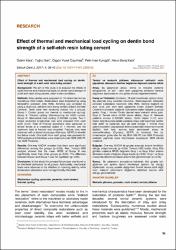| dc.contributor.author | Kara, Özlem | |
| dc.contributor.author | Sarı, Tuğrul | |
| dc.contributor.author | Özyılmaz, Özgün Yusuf | |
| dc.contributor.author | Kurugöl, Pelin İnan | |
| dc.contributor.author | Kara, Haluk Barış | |
| dc.date.accessioned | 08.07.201910:49:13 | |
| dc.date.accessioned | 2019-07-08T20:18:31Z | |
| dc.date.available | 08.07.201910:49:13 | |
| dc.date.available | 2019-07-08T20:18:31Z | |
| dc.date.issued | 2017 | en_US |
| dc.identifier.citation | Kara, Ö., Sarı, T., Özyılmaz, Ö. Y., Kurugöl, P. İ. ve Kara, H. B. (2017). Effect of thermal and mechanical load cycling on dentin bond strength of a self-etch resin luting cement. Selçuk Dental Journal, 4(2), 36-43. https://dx.doi.org/10.15311/1441.330615 | en_US |
| dc.identifier.issn | 2148-7529 | |
| dc.identifier.uri | https://hdl.handle.net/20.500.12511/338 | |
| dc.identifier.uri | https://dx.doi.org/10.15311/1441.330615 | |
| dc.description.abstract | Effect of thermal and mechanical load cycling on dentin bond strength of a self -etch resin luting cement. Background: The aim of this study is to evaluate the effects of cyclic thermal and mechanical loads on dentin bond strength of a self-etch resin luting cement under in vitro conditions. Methods: Inlay cavities were prepared on 18 caries-free human mandibular third molars. Restorations were fabricated by using feldspathic porcelain (Vita VM9). Bonding was achieved by using a dual-cure, self-etch resin luting cement (Clearfil Esthetic Cement). Teeth were then randomly divided into 3 groups: Group I: Control group (no thermal or mechanical cycling). Group II: Thermal cycling (thermocycling for 5.000 cycles). Group III: Mechanical load cycling (1.200.000 cycles). Two Ishape sectioned longitudinal cuts were prepared from each tooth (n:12). Total of thirty-six specimens were subjected to tensile forces at a crosshead speed of 1 mm/min, and the maximum load at fracture was recorded. Fracture sites were observed with a stereomicroscope (Olympus, SZ-PT) to identify the failure mode. One tooth from each group was prepared for SEM analysis and interfaces were observed under SEM (435 VP; Leo SEM Products). Results: One-way ANOVA revealed that there were significantdifferences among the groups (p<0.05). Also, Tukey’s HSD analysis showed that the mean MTBS of Group III was significantly lower than other groups (p<0.05). The difference between Group I and Group II was not significant (p>0.05). Conclusion: In this study the principal failure type was found to be interfacial (adhesive) for all groups. Additionally, mechanical loads were observed to be effective on bonding stability while temperature alterations were not significantly influential. | en_US |
| dc.description.abstract | Termal ve mekanik yükleme siklusunun self-etch rezin yapıştırma simanının dentine bağlanma dayanımı üzerine etkisi Amaç: Bu çalışmanın amacı, termal ve mekanik yükleme döngülerinin, bir self - etch rezin yapıştırma simanının dentine bağlanma dayanımını in vitro şartlar altında değerlendirmektir. Gereç ve Yöntemler: Çürüksüz, 18 adet mandibular üçüncü molar diş üzerinde inlay kaviteleri hazırlandı. Restorasyonlar, feldspatik porselen kullanılarak hazırlandı (Vita VM9). Dentine bağlantı bir dual- cure, self- etch rezin yapıştırma simanı (Clearfil Esthetic Cement) kullanılarak sağlandı. Sonrasında dişler rastgele üç gruba ayrıldı: Grup I: Kontrol Grubu (termal veya mekanik siklus yok). Grup II: Termal siklus (5.000 termal siklus). Grup III: Mekanik yükleme siklusu (1.200.000 siklus). Herbir dişten (n:12) uzun eksen doğrultusunda kesiler yapılarak ikişer adet I-şeklinde kesitler elde edildi ve toplamda otuz altı adet örneğe, 1 mm/dk hızla çekme kuvvetleri uygulanarak kırılma sırasındaki maksimum kuvvet ölçüldü. Kırık hattı, ayrılma tipini tanımlamak amacı ile stereomikroskop (Olympus, SZ-PT) ile incelendi. Her bir simantasyon grubundan bir diş SEM (435 VP; Leo SEM Products) analizleri yapılmak üzere hazırlanarak arayüzeyler SEM altında incelendi. Bulgular: One-way ANOVA ile gruplar arasında anlamlı farklılıklar olduğu ortaya konuldu (p<0.05). Tukey's HSD analizi, Grup III'te görülen ortalama MTBS değerinin Grup I ve Grup II'den anlamlı derecede düşük olduğunu ortaya koydu (p<0.05). Grup I ve Grup II arasında istatistiksel olarak anlamlı fark görülmemiştir (p>0.05). Sonuç: Bu çalışmanın sonuçlarına bakılarak, tüm gruplar için gözlenen asıl ayrılma tipinin interfasiyal (adeziv) tip olduğu söylenebilir. Ayrıca, sıcaklık değişimleri önemli derece etkili değil iken, mekanik yüklemenin bağlanma stabilitesi üzerine etkili olduğu görülmektedir. | en_US |
| dc.language.iso | eng | en_US |
| dc.rights | info:eu-repo/semantics/openAccess | en_US |
| dc.subject | Mechanical Cycling | en_US |
| dc.subject | Porcelain | en_US |
| dc.subject | Porselen | en_US |
| dc.subject | Resin Cement | en_US |
| dc.subject | Thermal Cycling | en_US |
| dc.subject | Mekanik Yükleme | en_US |
| dc.subject | Porselen | en_US |
| dc.subject | Rezin Simant | en_US |
| dc.subject | Termal Yükleme | en_US |
| dc.title | Effect of thermal and mechanical load cycling on dentin bond strength of a self-etch resin luting cement | en_US |
| dc.title.alternative | Termal ve mekanik yükleme siklusunun self–etch rezin yapıştırma simanının dentine bağlanma dayanımı üzerine etkisi | en_US |
| dc.type | article | en_US |
| dc.relation.ispartof | Selçuk Dental Journal | en_US |
| dc.department | İstanbul Medipol Üniversitesi, Diş Hekimliği Fakültesi, Protetik Diş Tedavisi Ana Bilim Dalı | en_US |
| dc.authorid | 0000-0003-4802-1604 | en_US |
| dc.authorid | 0000-0002-9292-2074 | en_US |
| dc.identifier.volume | 4 | en_US |
| dc.identifier.issue | 2 | en_US |
| dc.identifier.startpage | 36 | en_US |
| dc.identifier.endpage | 43 | en_US |
| dc.relation.publicationcategory | Makale - Ulusal Hakemli Dergi - Kurum Öğretim Elemanı | en_US |


















